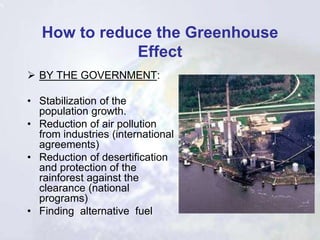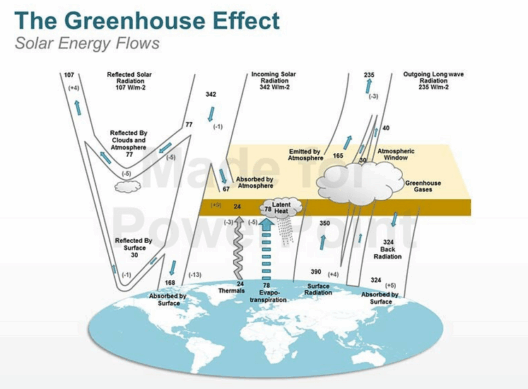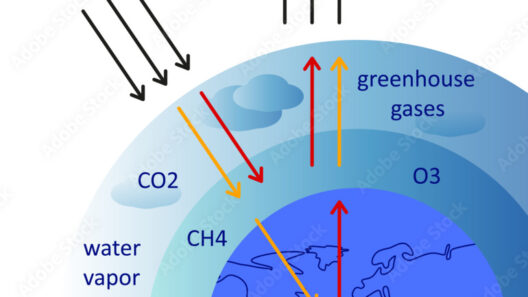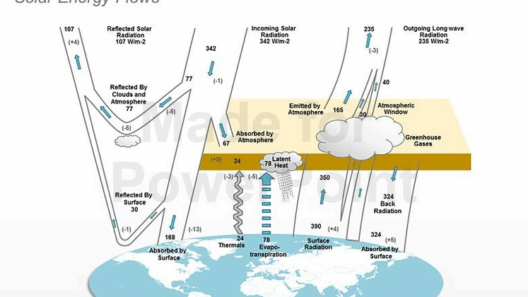The Greenhouse Effect is often touted as the pivotal factor in contemporary climate discourse. Its implications for global temperatures are profound and far-reaching. Understanding how the greenhouse effect operates is not merely an academic exercise; it is essential for grasping the reality of global warming and its consequences for our planet.
The greenhouse effect describes the process by which certain gases in Earth’s atmosphere trap heat. This mechanism is critical for maintaining the planet’s temperature and making it hospitable for life. However, anthropogenic activities, especially since the Industrial Revolution, have significantly amplified this effect, leading to alarming increases in global temperatures.
As we delve into this intricate issue, it is imperative to analyze the fundamental mechanisms of the greenhouse effect, explore its connection to global warming, and examine potential consequences for both the environment and humanity.
Understanding the Fundamental Mechanism of the Greenhouse Effect
At its core, the greenhouse effect operates through a simple yet remarkable process. Solar radiation from the sun reaches Earth, warming its surface. Subsequently, the planet radiates this heat back into space. However, greenhouse gases (GHGs) such as carbon dioxide (CO2), methane (CH4), nitrous oxide (N2O), and water vapor, among others, absorb a portion of this outgoing infrared radiation, effectively trapping heat within the atmosphere.
This phenomenon is akin to a natural blanket enveloping the planet, ensuring temperatures remain within a range conducive to life. Without the greenhouse effect, Earth’s average temperature would plummet to approximately -18 degrees Celsius, rendering it largely inhospitable.
However, the balance of this system has been disrupted. Human activities, particularly the combustion of fossil fuels, deforestation, and industrial processes, have drastically increased the concentration of these GHGs. For instance, since the late 19th century, CO2 levels have surged by more than 40 percent, primarily due to fossil fuel burning and land-use changes.
The Role of Different Greenhouse Gases in Global Warming
Not all greenhouse gases contribute equally to global warming. Each gas has a unique Global Warming Potential (GWP), which measures its capacity to trap heat in the atmosphere over a specified period, typically 100 years.
Carbon Dioxide is the most prevalent of the greenhouse gases and accounts for approximately three-quarters of emissions from human activities. Its permanence in the atmosphere is particularly concerning, as it can persist for centuries, leading to long-term warming effects.
Methane, on the other hand, although less abundant, has a GWP approximately 84 times that of CO2 over a 20-year period. Methane emissions primarily originate from agricultural activities, livestock digestion, and landfills. Reducing methane emissions is critical for achieving quick climate benefits due to its brief atmospheric lifespan.
Nitrous oxide, resulting largely from agricultural practices, has a GWP nearly 264 times greater than CO2 on a century scale. These potent gases, coupled with others such as fluorinated gases, compound the greenhouse effect significantly.
The Amplification of Climate Change Effects
The intensification of the greenhouse effect is not merely an abstract scientific phenomenon; it has tangible, dire consequences for the planet. As global temperatures rise, a cascade of environmental alterations occurs. These include extreme weather events, melting polar ice caps, rising sea levels, and shifting ecosystems.
Extreme weather events have increasingly become the norm, with stronger hurricanes, prolonged droughts, and unprecedented heatwaves affecting millions worldwide. The frequency and intensity of these events are correlated with rising temperatures and the consequent increase in atmospheric moisture, leading to violent weather patterns.
Additionally, the alarming rate at which glaciers and polar ice caps are melting contributes significantly to rising sea levels. This phenomenon poses a severe threat to coastal communities, with projections indicating that billions of people may be displaced due to inundation by rising waters.
The effects of climate change also heighten ecological destabilization. Wildlife habitats face significant alterations and fragmentation, forcing species to adapt, migrate, or face extinction. The delicate balance of ecosystems is at risk, leading to a loss of biodiversity—a key component of resilient natural systems.
Economic Ramifications: The Cost of Inaction
The repercussions of escalating global temperatures extend beyond environmental degradation. Economically, the costs associated with climate change are soaring. Increased expenditures on disaster relief, rebuilding efforts, and the adaptation of infrastructure to withstand new climatic realities weigh heavily on national and local budgets.
Moreover, the agricultural sector faces significant challenges. Shifts in weather patterns disrupt traditional farming cycles, jeopardizing food security globally. Diminishing crop yields, associated with extreme temperatures and unpredictable rainfall, exacerbate hunger issues in vulnerable populations.
These economic strains necessitate a comprehensive, global response to mitigate greenhouse gas emissions and adapt to changes already set in motion. The transition to renewable energy sources, sustainable agricultural practices, and efficient waste management are among the solutions that can curtail the greenhouse effect’s influence on global warming.
Conclusion: The Imperative for Action
As the evidence mounts regarding the greenhouse effect’s role in global warming, it is increasingly clear that concerted action is essential. Every increment of temperature increase brings with it the potential for profound disruption, highlighting the urgency of addressing greenhouse gas emissions. Collaborative efforts at the international level, paired with grassroots movements, can embody the change necessary to combat this existential threat effectively.







